The Story of the Airborne Rigger
Compiled from the Archives of the US Army Quartermaster Museum and oral interviews
by K. Born
Introduction
In the spring of 1950, with the start of the Korean War, the Quartermaster Corps was formally assigned the mission of procurement, storage, maintenance and issue of air supply equipment and the training of soldiers in aerial delivery. What follows is a short history of Quartermaster Aerial Delivery.
World War II
The Parachute Test Platoon
The Army formed its first Airborne unit in 1940, a Parachute Test Platoon of 2 officers and 48 enlisted soldiers, at Fort Benning, Georgia. This unit conducted the Army’s first official parachute jump on 16 August 1940. These original paratroopers packed and maintained their own chutes. Soldiers jumped with one parachute that was permanently issued to him. This platoon had a small parachute maintenance element consisting of 1 warrant officer and 2 enlisted men on detached service from the Army Air Corps. These supporting “riggers” provided technical supervision over each jumper in the preparation of his own parachute. During these formative days, airdrop of equipment was at a very primitive stage of development. Some of the enlisted members of this pioneer airborne unit, such as John Ward, later became career Parachute Riggers.
Expansion of Airborne Units
When the Army expanded airborne training to fill its new Airborne Divisions (11th, 13th, 17th, 82nd, 101st) it could no longer afford the extra two weeks or more it took to train soldiers to pack their own parachutes. To shorten the time it took to train paratroopers and thus increase the number trained, the Army organized parachute packing and rigging support organizations. The first parachute packing and maintenance school was activated at Fort Benning, Georgia. In 1942 a Parachute Battalion was authorized 13 parachute NCOs and three junior enlisted men to maintain parachute equipment. By 1944 the Service Company, Infantry Parachute Regiment was authorized 3 officers, 30 NCOs and 17 other enlisted men to provide parachute support to the infantry regiment.
Airdrop of supplies and equipment was first developed as a ad hoc expedient when other means of resupply were not available. Most drops were accomplished by the C-47 “Dakota” cargo plane, but bombers and even fighters were adapted to drop supplies in some situations.
European Theater
In the European Theater Quartermaster soldiers were widely used for packing, loading, and lashing supplies in airplanes and were frequently called upon to kick the supplies out over the drop zones.
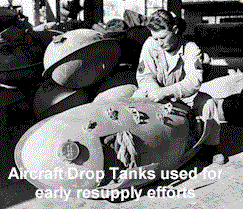
Some of the earliest airdrops were made in Italy. These relied largely on improvised packing and dropping methods. An example is the winter of 1943 when some Fifth Army units were cut off by German counterattacks in the mountains around Cassino. Because of the isolation of the positions, flooding and the quagmire roads, even pack animals were unable to reach some of the positions. Quartermaster personnel of Depot 5N60 of the Peninsular Base Section packed food and clothing into empty detachable fuel tanks normally carried by fighter planes. These “belly tanks” were flown to Naples, attached to the bomb racks of A-36 bombers and ejected over the stranded units. This method of supply was considered a purely emergency measure only to be used when “normal” supply methods were unavailable.
D-Day Invasion
In Northwest Europe the use of air supply was much more widespread, but the emphasis was on airlanded supply. The night before the D-Day invasion two American Airborne Divisions, the 82nd and the 101st, conducted personnel and equipment drops to secure key terrain behind the invasion beaches. Around 69 tons of supplies were airdropped to these divisions through D+8. In the following months General Patton’s Third Army led the race across France. His forces soon outran its ground supply capabilities and air supply was used to supplement the high speed road operation called the “Red Ball Express.”
Battle of the Bulge
The Germans mounted a 24-division surprise counterattack in December 1944, commonly called the “Battle of the Bulge.” The 101st Airborne Division was rushed to defend the key road junction of Bastogne and was eventually surrounded by the Germans. From 23 to 27 December the Division was resupplied by a series of airdrops which employed around 700 planes dropping 976 tons of supplies. The flying Quartermasters had kept the troops in fighting supplies and rations until Bastogne was relieved.
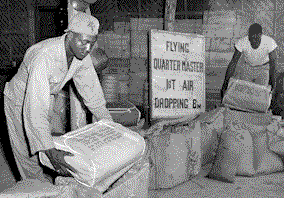
Pacific Theater Throughout the island fighting in the Pacific air supply was of great importance. But the most widespread use and highest dependence on air drops was in Burma and parts of China. Throughout the theater provisional units were formed from Quartermaster soldiers to store, pack and load aerial delivery items.
The Sixth Army organized the Provisional (Quartermaster) Air Supply Company in early 1942. Later redesignated as the 11th Cargo Resupply Squadron, it was the first Army unit specifically designated to conduct routine aerial resupply missions.
A good example of improvisation in dropping supplies into Burma was use of the 3841st & 3340th Quartermaster Truck Companies and later the 518th Quartermaster Battalion (Mobile) to warehouse, pack and drop supplies. These units were given limited training in theater and initial drops used trial and error methods. During a 10-month period of jungle fighting, between 25,000 and 100,000 soldiers were almost entirely dependent upon parachuted, free-dropped or airlanded supplies.
Quartermaster soldiers dropped food, ammunition and medical supplies to the 96th Division on Okinawa in April 1945. At the end of the war Quartermaster units and 20th Air Force began “relief bombing” food, medicine and clothing over remote prison camps which held Allied POWs in the Pacific Theater.
Quartermaster Corps Assigned Aerial Delivery Mission
After World War II the Army Air Force controlled most aerial delivery responsibilities. The National Security Act of 1947 created an independent U.S. Air Force. This caused some initial confusion about the delineation of aerial supply functions between the Army and the Air Force.
In March 1950 the Quartermaster General named an Ad Hoc Committee to look at the possibility of assuming the Aerial Delivery mission. The committee was composed of experts from the active Airborne Divisions, the Army General Staff, the Office of the Chief of Staff of the Army, Army Field Forces, the Quartermaster General’s Office and others with interests in airborne matters. Distinguished airborne pioneers such as General Matthew B. Ridgeway and Major General James M. Gavin provided advice to the committee. The committee’s recommendations and findings that the Quartermaster Corps should assume the Aerial Delivery mission from the U.S. Air Force were approved by the Department of the Army on 20 July 1950.
“Rigger School” – Fort Lee
In January 1951 the Quartermaster School approved an aerial delivery training program for Quartermaster soldiers, with courses in parachute packing, maintenance, and aerial delivery. The first class opened on 21 May 1951 at Fort Lee, Virginia that consisted of twelve weeks of instruction for both officers and enlisted men. All students were required to be airborne qualified and in good physical shape.
The Jeffersonville Quartermaster Depot was assigned to repair and maintain air delivery equipment. The Richmond Quartermaster Depot was responsible for purchase, storage and worldwide issue of air delivery items.
Early Aerial Supply Units
There were three types of Quartermaster units designed for Aerial Delivery:
Quartermaster Aerial Supply Company (84 personnel) – trained for heavy airdrop these units loaded supplies into airdrop platforms or containers, lashed them to the inside of the aircraft and ejected them over the drop zone. This unit was designed to provide continued air supply to troops cut off from ground supply.
Quartermaster Parachute Maintenance Company (242 personnel) – was an integral unit of each airborne division. This company packed and repaired all of the division’s individual and cargo parachutes. It was also responsible for recovering air delivery items for reuse.
Quartermaster Air Equipment Repair Company (148 personnel) – was responsible for more extensive, depot level, parachute and air delivery item repair. Heavy drop kits for jeeps, howitzers and other equipment was normally rebuilt by this unit.
By January 1952 the following units had been established:
8081st Quartermaster Aerial Supply Company at Headquarters, assigned to the Far East Command
187th Quartermaster Parachute Maintenance Detachment assigned to the 187th Regimental Combat Team, Far East Command
557th Quartermaster Parachute Aerial Supply Company, assigned to Headquarters, Seventh Army, European Command
601st Quartermaster Aerial Supply Company, attached to the 11th Airborne Division, Fort Campbell, Kentucky
11th Quartermaster Parachute Maintenance Company, an organic unit of the 11th Airborne Division, Fort Campbell, Kentucky
82nd Quartermaster Parachute Maintenance Company, an organic unit of the 82d Airborne Division, Fort Bragg, North Carolina
623rd Quartermaster Air Equipment Repair Company, assigned to the Infantry Center, Third Army, Fort Benning, Georgia
Quartermaster Parachute Maintenance Detachment, assigned to the Infantry School, Fort Benning, Georgia
Quartermaster Parachute Maintenance Detachment, assigned to the 508th Regimental Combat Team, Fort Benning, Georgia
Korea
With the war in Korea “logistic by parachute” became an established part of supporting combat operations. The poor weather, lack of road/rail networks and the brutal terrain created huge obstacles to resupply. Korea marked the first large scale use of aerial resupply, heavy drop and the standardization of airdrop procedures/units.
At the beginning of the war the Eighth Army Air Transportability Training Center (ATTC) at Matushima Air Force Base, Sendai, Japan had most of the trained air delivery specialists in the theater. These men were skilled in rigging for airland procedures. Unfortunately, there was a lack of well-trained and experienced airdrop personnel. Early on about 50% of all supplies dropped were lost.
During this war the C-54, C-119 and the venerable C-47 cargo planes were use for air drops. The plane best adapted to air delivery was the C-119 “Flying Boxcar”. It had removable clam-shell rear doors and its floor was equipped with a roller system that facilitated the drop of heavy equipment.
8081st Quartermaster Air Supply and Packaging Company
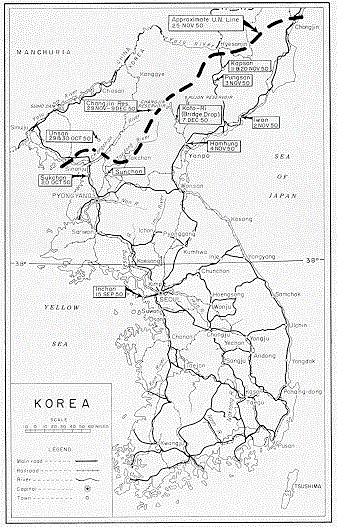
In response to the need for experienced riggers and due to increased airdrop requirements, the 2348th Quartermaster Airborne Air Supply and Packaging Company (later redesignated at the 8081st) was activated at Fort Campbell, Kentucky on 31 July 1950. The 2348th drew its initial personnel from 11th and 82d Airborne Divisions as well as Quartermaster soldiers from Fort Lee, Virginia. The Lee soldiers were not airborne, they became jump qualified in theater, but they had supply packing experience that was priceless.
The unit was rushed to Japan on 2 September 1950, the 8081st trained intensively on packing and rigging heavy equipment. Upon completion of training the unit moved to Kimpo Airfield, Korea to support the 187th Airborne Regimental Combat Team (RCT) which had arrived from Fort Campbell. The 8081st worked around the clock to support the first combat jump of the Korean War when the 187th RCT jumped into the Sukchon-Sunchon area of North Korea to cut off retreating communist forces on 20-21 October 1950. Thirty members of the 8081st participated in this jump, fighting alongside the 187th during the initial assault and later recovering more than a million dollars worth of parachutes and air delivery equipment. At the end of this mission the 8081st returned to Japan and continued to support aerial delivery operations.
Although the 8081st had a close association with the 187th RCT (and its 187th Quartermaster Parachute Maintenance Detachment) it supported a number of units throughout Korea.
Chosion Reservoir Bridge Drop
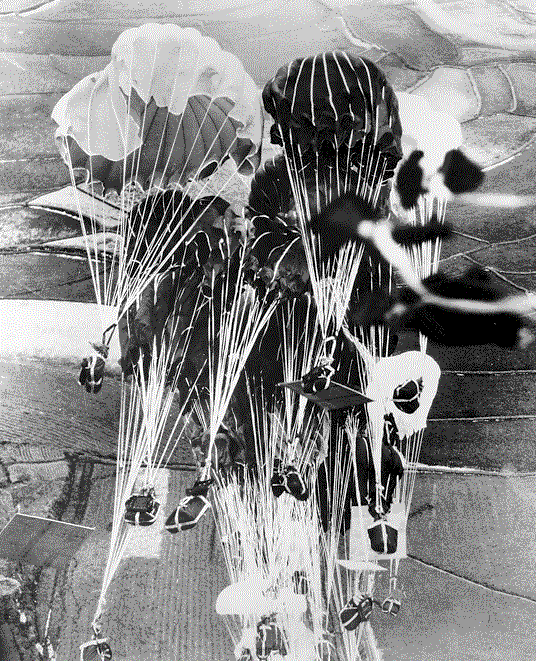
Perhaps the most famous drop was the first ever airdrop of an M-2 treadway bridge, at Koto-Ri on 7 December 1950. Communist forces had surrounded parts of the 7th Infantry Division and the 1st Marine Division near the Chosion Reservoir. The Chinese had demolished part of a mountain road over an impassable ravine to their rear, blocking withdrawal by vehicle. The 8081st dropped 1,571 tons of supplies to sustain these 20,000 men from 29 November to 9 December 1950. In an effort to provide an escape route the 8081st constructed platforms for and rigged eight sections of an M-2 bridge that was at Yon-Po airstrip. The next day eight C-119s lifted off, each carrying a 4,500 lbs section of the bridge. In the air the Quartermaster Dropmasters extended the bridge sections 8 feet out of the rear of the aircraft to cut down the ejection time and increase drop accuracy. Dropping into an area only a few hundred feet long, the bridge sections arrived intact, testimony to the skill of the riggers of the 8081st. The Marines assembled the bridge which undoubtedly saved lives. This drop showed the high degree of improvisation, speed and ingenuity of the company. One soldier interpreted the Marines’ opinion after the drop:
“When it comes to handing out plaudits to the Army the Marines generally change the conversation to the Halls of Montezuma or talk about the weather. But if the talk gets around to the day the Army’s paratrooper Quartermasters airmailed them a bridge, the song is a lot sweeter.”
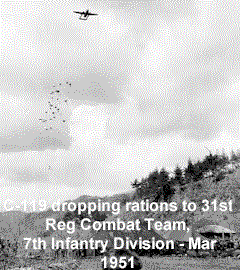
The 8081st also supported the second and final combat drop of the 187th RCT, along with the 2nd & 4th Ranger Companies, in Korea at Munsan-ni near the 38th Parallel on 23 March 1951. This was an attempt to block retreating Communist force north of Seoul. A total of 546 tons of heavy equipment and supplies (to include jeeps, trucks, and howitzers) were dropped in the operation.
By June 1951 fighting had stabilized near the 38th Parallel, ensuring more dependable ground transportation. This greatly reduced the need for supply by air.
At the end of the war the 8081st had conducted over 150 drops with a total weight of 12,112 tons using 119,000 parachutes. Aerial Delivery had reached maturity.
Vietnam
In Vietnam the helicopter came of age and with it came the ability to insert soldiers and supplies into the most remote areas on short notice. Aerial Delivery again reverted to the emergency supply role. Airdrop of supplies were most often used in “siege” situations were heavy enemy ground fire made landing helicopters or aircraft impractical. There was only one mass tactical combat jump made by conventional U.S. forces in Vietnam (There were several smaller scale jumps made by Special Forces units). On 22 February 1967, 845 soldiers of the 173rd Airborne Brigade (Separate) parachuted into the Tay Ninh area to block North Vietnamese Army units.
Three types of aircraft were used for aerial delivery in Vietnam, they were the C-7A “Caribou”, C-123 “Provider” and the C-130 “Hercules”. The C-130 conducted the majority of the drops due to its capacity and advanced navigation/radar systems.
109th Quartermaster Company (Air Delivery)
Stationed at Fort Campbell, Kentucky from September 1965 to 22 July 1966 the 109th supported the 101st Airborne Division with over 600 heavy drops during that period. In September 1966 the entire unit arrived in Cam Ranh Bay, Vietnam and was assigned to the 96th Supply and Services Battalion (DS). The 383rd Quartermaster Detachment (Aerial Supply) moved from Saigon to Cam Ranh Bay in November 1966 and was attached to the 109th. With the addition of the 383rd, daily rigging capability was 250 short tons. In December 1965 the company was reassigned to the 278th Supply and Services Battalion.
The 109th performed its first heavy drop missions in Vietnam from 21-28 November 1966. The company dropped 123 short tons of JP-4 (aircraft fuel) and 19 short tons of rations. In early 1967 General William C. Westmoreland, the Commander of U.S Army Vietnam visited the company. During his stay General Westmoreland stated that he had asked for an air delivery unit in Vietnam in order to “relieve the load on the helicopters.” In April 1966, during Operation JUNCTION CITY, conducted in Tay Ninh province, the 109th made the largest 24 hour airdrop of supplies, 503 short tons.
First Combat use of LAPES
In mid-August 1967 the company conducted test drops of ammunition and construction materials using the experimental Low Altitude Parachute Extraction System (LAPES). This system allowed an aircraft to discharge its load without landing. As the plane flew only a few feet above the ground a parachute was released that would pull the cargo pallet out of the aircraft and onto the runway. In September 1967 the 109th used the LAPES system to deliver 567 short tons of construction materials to the Marines at Khe Sanh for emergency runway repair. This effort earned the company a letter of commendation from the Deputy Commanding General, U.S. Army Vietnam:
“It is with a sense of deep personal satisfaction that I commend the officers and men of the 109th Quartermaster Company (Air Delivery) for their outstanding contribution during the Khe Sanh air delivery operation conducted 5 through 10 September 1967. The successful delivery of the critically needed construction materials to restore the Khe Sanh airfield was largely dependent upon the professional knowledge and competence of these men. The timely movement of the requisite air items from Cam Ranh Bay to Da Nang, and the professional rigging which assured the successful delivery of the AM-2 matting by the Low Altitude Parachute Extraction System (LAPES) were truly outstanding. Please express my appreciation to those responsible and particularly Majors A.B. Lanier and C.J. Williford, who effectively engineered this operation. The results of this operation will be invaluable in future staff planning and operational missions involving air delivery. Bruce Palmer, Jr., Lieutenant General, U.S. Army, Deputy Commanding General”
In October 1967 the 109th rigged 2,883 short tons of all classes of supplies which were dropped at Khe Sanh, Special Forces Camps at Lang Vei and Pluoc and elements of the 1st Cavalry Division on Hill 63 near An Truong. The company used both LAPES and the Container Delivery System (CDS) for these drops.
Khe Sanh
Khe Sanh was a strategic base blocking a vital North Vietnamese Army infiltration route into to South Vietnam. In response to increased enemy activity the base at Khe Sanh was reinforced in January 1968 with thousands of U.S. Marines and South Vietnamese troops. Over 6,000 allied troops were within Khe Sanh’s defensive perimeter. These troops were surrounded by almost 20,000 North Vietnamese soldiers who were thought to be in the Khe Sanh area. By 21 January an enemy rocket and mortar attack destroyed the ammunition storage area. The debris from this blast covered half the Khe Sanh runway temporarily closing the only means of resupply for this embattled outpost. Over the next 78 days emergency aerial delivery helped keep Khe Sanh alive delivering 8,120 tons of vital supplies by airdrop.
In the month of February 1968 the 109th Quartermaster Company broke the standing airdrop record established in 1952 by delivering 3,123 short tons of supplies to Khe Sanh under some of the most adverse weather and tactical conditions.
Other Rigger Units in Vietnam
The 109th was but one of four Quartermaster Company and Detachment sized rigger units that served in Vietnam. There were also other units such as the riggers in the 5th Special Forces Group and 101st Quartermaster Company (Provisional), but documentation on these are limited. Others rigger units serving in Vietnam were:
383rd Quartermaster Detachment
In May 1965, a group of men were taken from the 109th Quartermaster Company, then at Fort Lee, Virginia, to form the nucleus of the 383rd Quartermaster Detachment. One month later the 383rd received orders for Vietnam. In November, 1966, the 383rd was reattached to the 109th QM Company at Cam Ranh Bay, and remained an important platoon of the 109th until it moved to Bien Hoa in December, 1967. The 383rd was inactivated on March 20, 1972, while still in the Republic of Vietnam. It earned three Meritorious Unit Commendations for service in Vietnam.
549th Quartermaster Company
The 549th Quartermaster Company stationed in Japan. While neither assigned nor stationed in Vietnam, this unit sent platoon sized and smaller elements on TDY (Temporary Duty) to Vietnam and Thailand. One platoon was attached to the 383rd QM Detachment at Bien Hoa in 1968 during the Khe Sanh and Tet airdrops. Other riggers of the 549th were stationed in Thailand where they rigged loads for CIA missions. In May 1972, a platoon was sent to Tan San Nhut Air Base near Saigon to perform high altitude drops for ARVN troops and American advisors during the siege at An Loc. The unit was inactivated 21 December 1974 on Okinawa.
623rd Quartermaster Company
Stationed at Cam Ranh Bay, the 623rd’s mission was to provide Depot support for supply and field maintenance, and reclamation of air delivery equipment. The 623rd made major contributions in Junction City, Khe Sanh, and A Shau Valley. It earned a Meritorious Unit Commendation for service in Vietnam. Inactivated on 20 December 1968 in Vietnam (This unit was reactivated in 1994 at Fort Bragg, NC).
Grenada – “Urgent Fury”
On 25 October 1983 over 500 Army Rangers from the 1st and 2nd Ranger Battalions made a combat jump into Point Salines Airport, Grenada. This drop, part of the largest American combat operation since Vietnam, was conducted at 500 feet to avoid enemy anti-aircraft fire from the surrounding hills. The success of this mission was due in part to the riggers that packed the parachutes used for this operation.
Panama – “Just Cause”
During Operation Just Cause in Panama a brigade task force from the 82nd Airborne Division parachuted into Torrejos-Tocumen Airport east of Panama City on 20 December 1989. This was conducted at night with soldiers jumping at 500 to 800 feet and equipment dropped at 800 to 1,200 feet. In support this operation E Company, 407th Supply and Transport Battalion (with augmentation of riggers from the 1st Corps Support Command) rigged CDS bundles and heavy drop platforms that included M551 Sheridans, howitzers, engineer equipment and various configurations of HMMWVs. They also packed all individual parachutes used by the 2,300 soldiers involved in the drop.
Elements of the 75th Ranger Regiment conducted a combat jumps at Torrejos-Tocumen and at Rio Hato Airports.
C-130 and C-141 aircraft airdropped over 683 tons of equipment and supplies during this operation. Fourteen Air Force aircraft sustained battle damage during these drops.
Riggers See Combat in Panama
There were 6 riggers from E-407th attached to the HHC, 3rd Battalion, 504th Infantry, 82nd Airborne Division which was in Panama for the jungle training. The riggers mission was to pack parachutes for a training jump before the start of jungle school. On 17 December they were ordered to draw weapons, live ammunition and live grenades. They patrolled the area until 19 December. These riggers saw actual combat with HHC, 3-504th Inf when this unit assaulted the Panamanian Defense Force (PDF) barracks on Fort Espinar at midnight on the 20th of December. The firefight lasted around 30 minutes and ended when the Panamanian forces were threatened with an airstike. None of the riggers were wounded. One was awarded the Army Commendation Medal with V (valor) device for this action.
Desert Shield/Storm
Several aerial delivery units deployed to Southwest Asia during Operation Desert Shield/Desert Storm 1990-1991. They were: E-407th QM Company, 82nd Airborne Division; 421st Aerial Delivery Supply Company, USAR, Fort Valley, GA; 600th Aerial Delivery Equipment Repair & Supply Company, 1st COSCOM; 612th Aerial Delivery Supply Company, 1st COSCOM, and the 49th, 51st, 53rd Quartermaster Detachments (Air Drop), 1st COSCOM. These units supported a number of small equipment/supply drops.
Iraq – “Provide Comfort” Humanitarian Airdrop
At the end of Operation Desert Storm thousands of Kurdish refugees were on the brink of starvation in northern Iraq and refugee camps in Turkey. The 5th Quartermaster Detachment was deployed from Germany to Incirlik Air Base, Adana, Turkey to conduct emergency airdrop of relief supplies into northern Iraq. Rigging and airdrop to the Kurds lasted from 7 April to 1 May 1991. At the end of this operation the Detachment had rigged over 7,600 CDS bundles and packed over 6,700 parachutes.
The 5th used three methods of aerial delivery. The high velocity delivery method was the most frequently used, about 76% of total airdrops. It was used for items that could better survive impact such as packaged food. The low velocity method was used for 22% of the drops. It was ideal for dropping fragile items such as medial supplies, baby food jars and bottled water. The last, free drop, was used as a last resort when parachutes and other aerial delivery equipment was unavailable.
Over 3,000 members of the four armed services supported these drops. The Marine Corps brought in a detachment of parachute riggers from the Aerial Delivery Platoon, 1st Landing Support Battalion, 1st FSSG at Camp Pendleton, California to work side by side with Army riggers.
Doctor Marcel Bonnot from the French Ministry of Foreign Affairs observed the first airdrop while visiting a refugee camp near Uludere, Turkey on 8 April 1991. The arrival of the first aircraft was a dramatic and emotional scene. The noisy camp hushed when the sound of arriving airplanes was heard. At first most of the refugees rushed for cover, thinking the humming engines heralded a reappearance of Saddam’s air force. However, when no bombs began falling, eyes focused upward and followed a lumbering C-130 as it slowly circled the camp. A roll of toilet paper thrown from the plane tested wind direction. Suddenly, a series of large object dropped from the plane’s tail section. The fearful Kurds were astounded when gigantic white parachutes blossomed and bundles of food floated to the earth. The hungry people they mobbed the drop zone and each scrambled to capture one of the small brown plastic MRE packets. Despite the confusion on the ground, the lack of a distribution system, and poor understanding about the proper use of MRE rations, the Kurds in the camp realized that someone was helping them.
Bosnia – “Provide Promise” Humanitarian Airdrop
Quartermaster Riggers were key players in the humanitarian airdrop of relief supplies former Republic of Yugoslavia (Bosnia-Herzegovina) from February 1993 to the end of 1995. In this, the largest humanitarian airdrop in U.S. history, more than 30,000 bundles of humanitarian supplies were dropped. See Emerging Technology in Airdrop Operations.
The largest number of drops were high velocity drops from C-130s flying above 10,000 feet. The CDS bundles in these high velocity drops used A-22 cargo bags and five layers of honeycomb mounted on 3/4 inch plywood. A 26 foot ring slot parachute attached to this load reduced impact to 55 mile per hour. With proper padding even the most fragile medical supplies could be dropped without damage.
This operation saw a great deal of improvisation and modification to standard rigging practices. Over 200 different methods of rigging were developed to drop nonstandard loads of the hundreds of food and medical items donated by numerous countries.
TRIADS System Developed
Free drop was accomplished using TRIADS (TRIWALL aerial delivery system) that was developed during this operation. The system was essentially a cardboard TRIWALL box filled with 40 cases of individual Meals Ready to Eat (MREs). Once the boxes were ejected over the drop zone webbing holding the box together was yanked free by a static line. The precut boxes broke open scattering 480 MREs over a wide area, decreasing the chance of injury to people waiting on the ground.
Operation Provide Promise was total army and allied effort with riggers from the 5th Quartermaster Detachment, Germany; U.S. Army Italy, other U.S. Army Europe units, Reserve Component soldiers from Georgia and 20 riggers from Germany and France. U.S. C-130 along with German and French C-160 Transall aircraft flew thousands of missions together.
Haiti Relief Operations “Unified Response”
Humanitarian airdrops of food and water were conducted to provide immediate relief to earthquake victims in Haiti because airport congestion hampered the distribution of aid on the ground. The 11th Quartermaster Company, 189th Combat Support Sustainment Battalion, 82nd Sustainment Brigade at Fort Bragg, NC, rigged 718 Container Delivery Systems (CDS) G-12 bundles in support of Operation Unified Response. This airdrop of humanitarian supplies took place starting just 6 days after the earthquake with drops on 18 January 2010 and 23 January. A total of 152 of these CDS bundles, containing 48,960 MRE meals and 15,960 gallons of Bottled Water, were dropped by Air Force C-17s flying a 7 hour round trip from Pope Air Force Base to locations in and around Port-au-Prince, Haiti.
U.S. Army Quartermaster Museum, Fort Lee, Virginia
Last Updated: August 16, 2010
